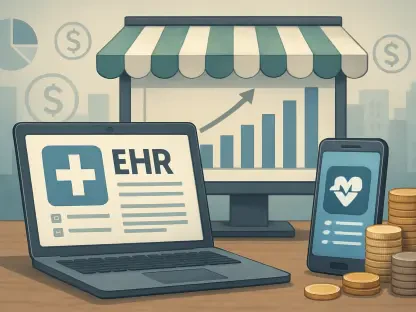In an era where healthcare innovation is paramount, telemedicine has emerged as a transformative solution, especially for vascular patients grappling with mobility challenges and limited access to specialized care, redefining how medical services are delivered through tools like video conferencing and mobile apps. This digital approach has gained significant traction since the COVID-19 pandemic underscored the necessity of remote options. Vascular conditions such as peripheral artery disease and aneurysms demand consistent monitoring and frequent specialist consultations, often posing logistical hurdles for patients. Telemedicine offers a critical lifeline by dismantling barriers of distance and inconvenience, enabling care from the comfort of home. This article delves into the profound dual impact of virtual platforms on vascular care, focusing on heightened patient satisfaction and the subsequent increase in provider referrals. While the benefits are substantial, the path to seamless integration reveals complexities that warrant closer examination.
Revolutionizing Access to Vascular Healthcare
Telemedicine is breaking down long-standing barriers to healthcare for vascular patients, a demographic often burdened by mobility limitations and the need for specialized attention. Many of these individuals, particularly the elderly, find traveling to distant clinics not only physically taxing but also financially draining. Virtual consultations provide an alternative, allowing patients to connect with experts without leaving their homes. This saves significant time and reduces costs associated with travel, making regular check-ups more feasible. Beyond logistics, the convenience of receiving timely medical advice through secure digital channels enhances the overall experience, as patients can avoid the stress of navigating hospital environments. Research indicates that this accessibility is a primary factor in elevating satisfaction levels, marking a pivotal shift in how care is perceived and accessed by those with chronic vascular conditions.
The psychological benefits of telemedicine further amplify its impact on vascular care delivery. For many patients, the anxiety tied to in-person medical visits can deter them from seeking necessary treatment. Engaging with healthcare providers through familiar surroundings via video calls or apps alleviates much of this stress, fostering a more relaxed dialogue about sensitive health concerns. This comfort translates into a willingness to maintain regular contact with specialists, ensuring that conditions are monitored closely and complications are addressed promptly. Unlike traditional settings where the clinical atmosphere might feel intimidating, telemedicine creates a space where patients feel heard and supported. This shift not only improves individual well-being but also reinforces the importance of adapting healthcare models to meet diverse patient needs in a rapidly evolving digital landscape.
Empowering Patients for Better Health Management
One of the standout advantages of telemedicine in vascular care lies in its ability to empower patients, giving them a more active role in managing their health. With the ease of scheduling virtual appointments and sharing real-time updates on symptoms through digital platforms, individuals gain a sense of control over their treatment journey. This immediacy in communication with providers means questions are answered swiftly, and concerns are addressed without delay, reducing the likelihood of neglected health issues. Such empowerment is crucial for adherence to complex treatment regimens often required for vascular conditions, including strict medication schedules and lifestyle adjustments. By fostering this proactive engagement, telemedicine helps patients transition from passive recipients of care to informed participants, a change that resonates deeply in chronic disease management.
This newfound autonomy also cultivates a stronger bond of trust between patients and healthcare providers, essential for long-term success in vascular care. Digital interactions, when supported by user-friendly and secure platforms, allow for consistent follow-ups that reinforce treatment plans and encourage accountability. Patients who feel supported in this way are more likely to stick to prescribed therapies and report improvements or setbacks promptly, leading to better health outcomes. Unlike sporadic in-person visits that might leave gaps in care, telemedicine ensures continuity, making it easier to track progress over time. This dynamic not only benefits individual health but also highlights the potential of virtual care to redefine patient-provider relationships, emphasizing communication and partnership over physical presence in a clinical setting.
Enhancing Provider Reach Through Patient Referrals
Patient satisfaction with telemedicine extends beyond personal benefits, creating a powerful ripple effect in the form of increased referrals for healthcare providers. When vascular patients experience positive outcomes and convenience through virtual consultations, they are more inclined to share their success stories with family, friends, and community members. This word-of-mouth promotion serves as a natural endorsement, expanding the reach of providers who adopt telehealth services. Unlike traditional care models where satisfaction might remain a private sentiment, the digital nature of telemedicine often prompts patients to advocate for the platforms and professionals who made a difference in their lives. This trend is reshaping how healthcare networks grow, with satisfied patients acting as organic ambassadors for innovative care delivery.
The impact of referrals driven by telemedicine also underscores a broader shift in healthcare marketing and trust-building. As patients vocalize their appreciation for accessible and effective virtual care, providers gain a competitive edge in attracting new clients who might otherwise face barriers to specialized vascular services. This dynamic creates a virtuous cycle: high satisfaction fuels referrals, which in turn bolster the adoption of telemedicine among hesitant or unaware populations. Different from conventional advertising, this organic growth is rooted in genuine patient experiences, lending credibility to telehealth as a viable and preferred option. The resulting expansion of patient bases not only benefits individual practices but also strengthens the case for integrating digital solutions into mainstream healthcare systems on a larger scale.
Bridging Gaps in Healthcare Equity
Telemedicine holds immense promise in addressing long-standing health disparities, particularly for vascular patients in underserved communities. Geographical isolation and financial constraints often prevent individuals in rural or low-income areas from accessing specialized care, exacerbating health inequalities. Virtual platforms mitigate these challenges by connecting patients with experts regardless of location, ensuring that quality treatment is no longer confined to urban centers. This democratization of healthcare aligns with global efforts to make medical services more inclusive, offering a pathway for marginalized groups to receive the attention they need without the burden of prohibitive costs or travel. The potential to level the playing field in vascular care is a compelling argument for expanding telehealth initiatives across diverse populations.
Moreover, the focus on equity through telemedicine reveals an opportunity to tailor interventions to specific community needs, further reducing disparities. By leveraging digital tools, healthcare systems can provide resources like multilingual support or culturally sensitive guidance, ensuring that language or cultural barriers do not impede access to care. This adaptability sets telemedicine apart from traditional models, where one-size-fits-all approaches often fail to address unique demographic challenges. Unlike past efforts that struggled with scalability, the current digital infrastructure allows for customized solutions that can reach even the most remote areas. As a result, vascular patients who were previously sidelined by systemic inequities now have a chance to engage with life-changing care, marking a significant stride toward a more just healthcare landscape.
Overcoming Barriers to Telehealth Implementation
Despite its many advantages, the adoption of telemedicine in vascular care is not without significant obstacles that demand attention. Technical challenges, such as unreliable internet connectivity or outdated devices, can disrupt virtual consultations, leaving some patients unable to fully benefit from these services. Additionally, a lack of familiarity with digital tools poses a hurdle, especially for older vascular patients who may feel overwhelmed by technology. These issues highlight a critical gap in access that could undermine the effectiveness of telehealth if left unaddressed. Ensuring that the infrastructure supports seamless interactions is vital, as is the need for user-friendly platforms that minimize the learning curve for all demographics. Without targeted solutions, the risk of excluding vulnerable groups from the benefits of telemedicine remains a pressing concern.
To counter these challenges, a concerted effort toward education and support is essential for making telemedicine inclusive in vascular care. Training programs tailored to different skill levels can empower patients to navigate digital platforms with confidence, while community partnerships can facilitate access to necessary technology, such as affordable devices or public internet hubs. Unlike standalone initiatives, a collaborative approach involving healthcare providers, tech companies, and local organizations can address both technical and social barriers effectively. This focus on accessibility ensures that the advantages of virtual care are not limited to tech-savvy or affluent populations but extend to everyone in need. By prioritizing such strategies, the healthcare sector can pave the way for equitable telehealth adoption, reinforcing its role as a cornerstone of modern medical practice.
Future Pathways for Telehealth in Vascular Care
Reflecting on the strides made, telemedicine has proven to be a pivotal force in enhancing satisfaction and driving referrals among vascular patients. The journey revealed how digital platforms tackled core barriers like distance and mobility, offering convenience while empowering individuals to manage their health proactively. Increased referrals from satisfied patients underscored the trust built through virtual care, amplifying provider reach. Addressing disparities also stood out as a key achievement, with telehealth extending specialized services to underserved communities. Though challenges like technical limitations persist, the overall impact remains transformative, reshaping perceptions of healthcare delivery.
Looking ahead, the focus should shift to actionable steps that solidify telemedicine’s role in vascular care. Investing in robust digital infrastructure and accessible training programs can bridge remaining gaps, ensuring no patient is left behind. Healthcare systems must prioritize user-friendly solutions and foster collaborations to provide technology access where needed. Exploring long-term outcomes through research will further refine telehealth applications, tailoring them to diverse needs. By committing to these initiatives, the potential of virtual care can be fully realized, setting a precedent for chronic disease management across specialties.









